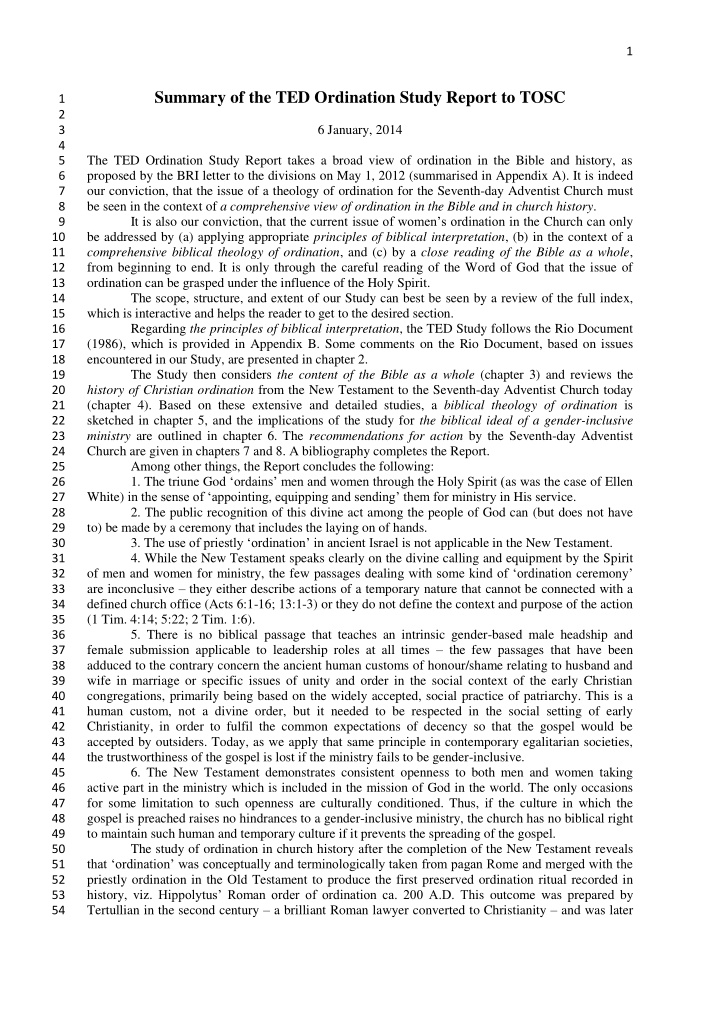



1 Summary of the TED Ordination Study Report to TOSC 1 2 3 6 January, 2014 4 5 The TED Ordination Study Report takes a broad view of ordination in the Bible and history, as 6 proposed by the BRI letter to the divisions on May 1, 2012 (summarised in Appendix A). It is indeed 7 our conviction, that the issue of a theology of ordination for the Seventh-day Adventist Church must 8 be seen in the context of a comprehensive view of ordination in the Bible and in church history . It is also our conviction, that the current issue of women’s ordination in the Church can only 9 10 be addressed by (a) applying appropriate principles of biblical interpretation , (b) in the context of a 11 comprehensive biblical theology of ordination , and (c) by a close reading of the Bible as a whole , 12 from beginning to end. It is only through the careful reading of the Word of God that the issue of 13 ordination can be grasped under the influence of the Holy Spirit. 14 The scope, structure, and extent of our Study can best be seen by a review of the full index, 15 which is interactive and helps the reader to get to the desired section. 16 Regarding the principles of biblical interpretation , the TED Study follows the Rio Document 17 (1986), which is provided in Appendix B. Some comments on the Rio Document, based on issues 18 encountered in our Study, are presented in chapter 2. 19 The Study then considers the content of the Bible as a whole (chapter 3) and reviews the 20 history of Christian ordination from the New Testament to the Seventh-day Adventist Church today 21 (chapter 4). Based on these extensive and detailed studies, a biblical theology of ordination is 22 sketched in chapter 5, and the implications of the study for the biblical ideal of a gender-inclusive 23 ministry are outlined in chapter 6. The recommendations for action by the Seventh-day Adventist 24 Church are given in chapters 7 and 8. A bibliography completes the Report. 25 Among other things, the Report concludes the following: 1. The triune Go d ‘ordains’ men and women through the Holy Spirit ( as was the case of Ellen 26 White) in the sense of ‘appointing, equipping and sending’ them for ministry in His service. 27 28 2. The public recognition of this divine act among the people of God can (but does not have 29 to) be made by a ceremony that includes the laying on of hands. 3. T he use of priestly ‘ordination’ in ancient Israel is not applicable in the New Testament. 30 31 4. While the New Testament speaks clearly on the divine calling and equipment by the Spirit of men and women for ministry, the few passages dealin g with some kind of ‘ordination ceremony ’ 32 are inconclusive – they either describe actions of a temporary nature that cannot be connected with a 33 34 defined church office (Acts 6:1-16; 13:1-3) or they do not define the context and purpose of the action 35 (1 Tim. 4:14; 5:22; 2 Tim. 1:6). 36 5. There is no biblical passage that teaches an intrinsic gender-based male headship and female submission applicable to leadership roles at all times – the few passages that have been 37 38 adduced to the contrary concern the ancient human customs of honour/shame relating to husband and 39 wife in marriage or specific issues of unity and order in the social context of the early Christian 40 congregations, primarily being based on the widely accepted, social practice of patriarchy. This is a 41 human custom, not a divine order, but it needed to be respected in the social setting of early 42 Christianity, in order to fulfil the common expectations of decency so that the gospel would be 43 accepted by outsiders. Today, as we apply that same principle in contemporary egalitarian societies, 44 the trustworthiness of the gospel is lost if the ministry fails to be gender-inclusive. 45 6. The New Testament demonstrates consistent openness to both men and women taking 46 active part in the ministry which is included in the mission of God in the world. The only occasions 47 for some limitation to such openness are culturally conditioned. Thus, if the culture in which the 48 gospel is preached raises no hindrances to a gender-inclusive ministry, the church has no biblical right 49 to maintain such human and temporary culture if it prevents the spreading of the gospel. 50 The study of ordination in church history after the completion of the New Testament reveals that ‘ordination’ was conceptually and terminologically taken from pagan Rome and merged with the 51 52 priestly ordination in the Old Testament to produce the first preserved ordination ritual recorded in history, viz. Hippolytus’ Roman order of ordination ca. 200 A.D. Th is outcome was prepared by 53 Tertullian in the second century – a brilliant Roman lawyer converted to Christianity – and was later 54
Recommend
More recommend